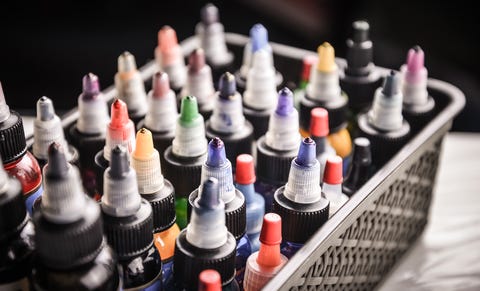Follow: Twitter | Instagram | Telegram | Truth Social | Podcast Membership|
Broadcasts: Rumble| HappyHour |This Wk wDrT | Brighteon | Bitchute | Tues Coffee
Learn about ECP: Health Center Cleveland, OH | Health Center Ventura, CA
Websites: DrTenpenny.com |Tenpenny Apparel| Tenpenny Supplements
+++++++++++++++++++++++++++++++++++++++++++
When I started to do the research for this article, I was jaw-dropped at the amount of available information that has been published about tattoos, including history, equipment, ingredients, contaminants, regulations, cosmetic vs medical applications. There are specific applications for various body parts including eyelids, lips, nipples and for medical conditions such as vitiligo, burns, and stretch marks. There is an entire industry built around tattoo removal using YAG lasers, alexandrite lasers, and high-frequency focused ultrasound machines.
I even found an entire textbook, called Cosmetic and Medical Tattoos: Technique and Application. Published in 2023, it has 30 chapters and costs $233!
A Little History
The art of tattooing goes back to ancient Egypt, at least 3000 BC. Other ancient cultures wore body figures as a symbol dedicating one to a certain god. It apparently was used as a ‘brand’ or symbol of servitude. Some tattoos represented a profession (such as a prostitute) or were used to encourage fertility or protection.
Mummies of Egyptian royalty were tattooed, indicating a cosmetic practice. Based on mummy tattoos, the artists used dark pigments, usually black, blue, or green, with little variation. Egyptians tinted their eyelids black with kohl (powdered antimony) or green with copper salts. The lips and cheeks were tinted red. Henna gave a golden red hue to the nails and the soles of the feet. The same apothecaries who prepared medicines for physicians prepared substances and treatments to be used in perfumes and cosmetics.
According to WorldHistory.com,
No written work on the subject of tattoos survives from ancient Egypt, so interpretation is always speculative. But it seems likely these tattoos were not simply adornments to make a woman more attractive to a man but served a higher purpose.
Why tattoos?
Again, a lot has been written about why people choose to get – or not get – tattoos. Although they have been around for more than 5,000 years, body art has exploded in both popularity and acceptance over the last 25 years. Tattoos are becoming more popular, with more than 50% of Americans under the age of 40 sporting tattoos.
A 2019 study done in South Africa and then reported in Psychology Today has a lot of interesting perspectives. Here’s an excerpt:
Among those who harbored negative views, they stated that tattoos were (in their own words), ugly, trashy, messy, cheap, and filthy. Similarly, they saw tattooed individuals as evil, satanic, dangerous, rebellious, ungodly, stupid, reckless, unprofessional, weird, not-Christian, associated with criminality, cruel, showoffs, outcasts, anti-social, bereft of morals, and defiant of society. A respondent expressed, “They want to feel a sense of belonging, attention, and want to be feared.”
Among those with positive views about tattoos, they saw them as attractive, and those who sport them as cool, trendy, fashionable, interesting, spontaneous, creative, artistic, free-spirited, more open/accepting, liberal, adventurous, brave, strong, courageous, and unafraid of commitment and pain. As one participant put it, “People with tattoos are the realest people [you] ever will meet.”
In my opinion, the older you are, the less chance you'll be forgiving and/or accepting of tattoos, especially large, overly-consuming, or grotesque designs.
Health Risks
Infections
Tattooing involves puncturing the skin about 100 times per second with needles and depositing ink 1.5 to 2 millimeters below the surface of the skin. It generally causes bleeding because the needles pierce the blood vessels. Contaminated tattoo ink can cause infections and serious injuries.
Reported problems with tattoo ink have ranged from superficial conditions (allergic reactions, inflammation, impetigo, or erysipelas – usually caused by strep or staph bacteria), to deeper, widespread complications (limb edema, swollen lymph nodes, cellulitis) and even life-threatening systemic complications (endocarditis, septic shock, and multi-organ failure). According to a national German survey of 3,411 tattooed individuals, 67.5% complained of health problems after tattooing; 10% were described as “moderate” and 1.8% described their side effects as “intense” to “very intense.”
Injection-site rashes, blisters, nodules, and granulomas have been reported that have resulted in permanent scarring. It has been reported that up to 20% of all piercings and tattoos have at least local infections.
As recently as June 2023, the FDA issued new guidance for manufacturers and users of tattoo inks. Also, according to the FDA:
Between 2003 and 2019, tattoo ink firms conducted 15 voluntary ink recalls, 14 of which resulted from findings of microbial contamination. Eight of these recalls occurred after the FDA conducted multiple surveys of tattoo inks available in the U.S. market and tested them for microbial contamination. Many of these inks were heavily contaminated with a variety of microorganisms, some of which (such as Pseudomonas aeruginosa and Bacillus cereus) can cause serious infections.
In 2018, an article in the Journal of Applied Microbiology reported that 49% of the surveyed tattoo inks on the U.S. market were contaminated with microorganisms. In 2019, consumers, tattoo artists, and retailers were alerted to the potential for serious injury from the use of certain tattoo inks contaminated with bacteria. Many of these products were removed from use.
MRI Burns
Tattooed patients undergoing magnetic resonance imaging (MRI) can develop mild-to-moderate complications during the procedure. Symptoms of severe burning can come on abruptly during MRI, sometimes requiring termination of the procedure. No skin burns have been seen. The symptoms were thought to be caused by metal pigments in the ink. Recovery was fast and complete after the procedure ended. MRI-induced tattoo complications are uncommon. However, in a review paper published in 2020, 17 cases had been reported, with five occurring in cosmetic tattoos.
Donating Blood
Historically, people have been advised to wait a year before giving blood after receiving a tattoo to reduce their risk of transmitting blood infections, particularly hepatitis A, hepatitis B, hepatitis C, or HIV.
However, in April 2020, the FDA updated its recommendations (pg. 11) and proposed the deferral period be reduced to three months. The FDA’s new rules make the presumption if one of these infections was contracted during the 3-months from the time of a tattoo procedure, the person would have detectable antibodies when screened. That said, you may want to obtain your tattoo at a state-regulated tattoo shop. These are routinely monitored for safe and clean tattooing practices, lowering the risk of infection.
Esthetic Changes
In addition to the long-term health effects of tattoos listed above, there are also some unconsidered aesthetic changes. The quality of the body “art” will change over time. As your skin ages and stretches, this will have an impact on the color, shape, and definition of the tattoos which are prone to fade, stretch, and wrinkle. The meaning of the tattoo could change as you age and life circumstances change. Your favorite girl/guy whose name is on your arm may be long gone and you might not feel the same about that quote from 15 years ago.
Tattoo vaccines
Fortunately, from my perspective, this experimental way to manipulate the human immune system hasn’t gotten out of the experimental phase (at least not yet!) There have been mouse studies with DNA vaccines to be delivered by tattooing because the inflammation caused by the tattoo procedure has been shown to induce higher specific humoral and cellular immune responses than intramuscularly injected DNA. This is thought to be a more “robust” response. Thankfully, this experimentation has yet to get traction or leave the lab.
Tattooing and Crime Victims
While ancient times often used tattoos as a form of ownership, skin signs and ‘branding’ are still used today in both human labor and sex trafficking industries. A study from 2021 sought to identify and possibly catalog skin signs reported in victims to create a framework for dermatologists and the broader medical community to appropriately screen patients at risk, and to assist with more timely identification of and intervention with affected persons.
After screening 577 pertinent records in the PubMed and Google Scholar databases for information about the physical signs of human trafficking in health care, 10 final studies were selected. Significant findings of rashes and tattoos were more likely in sex-trafficked patients, whereas burns and deep cuts were more likely to be found in labor-trafficked patients.
The paper advocates for very physician to perform a thorough physical examination and document all signs of injury, abuse, lesions, surgical incisions, tattoos, and piercings. A poor quality tattoo can be attributed to its “homemade nature” and should be highly suspected. Given the prevalence of mental health and behavioral manifestations of trafficking, the physician should also document any signs of anxiety, depression, posttraumatic stress disorder, drug abuse, and suicidal ideation. Unfortunately, these researchers were not able to identify any standardized signatures for medical and police authorities to add in identifying this horrible and pervasive problem.
Tattoos, especially in the criminal justice system, are somewhat different and can be good identifiers for police officers who are given descriptions of a suspect. In Florida, for example, the police have set up a specific tattoo and markings database to help in identifying potential suspects of crimes, or when determining if certain tattoos may affiliate the person with a gang, creed, or organization. However, as more and more young persons are becoming inked, the use of tattoos as evidence is still in the early stages across the country.
Ink Toxicity
Tattoo inks are not classified as pharmaceutical or cosmetic. The body is directly exposed to the contained substances through puncturing the skin. Pigments may accumulate throughout the body via the lymphatic system.
Tattoo application is widely performed all over the world; the injection of colored substances into the skin may pose a risk for allergies, inflammation, and systemic disease as previously stated. In one study, 56 inks purchased from 4 different supply companies were analyzed for metal concentrations. Some of the elements found in high doses were aluminum, barium, cadmium, chromium, mercury, nickel, cobalt, copper, iron, and zinc. Of the 56 inks tested, chromium, nickel, and cobalt exceeded the safe allergy limit.
One simple solution to removing the heavy metals from the ink is Touchstone Essential’s Pure Body Extra zeolite spray. Zeolite is a one-way basket that scoops up the heavy metals found in the inks to gently remove them from the body. If you really want to rid your body of your art choice, consider removal. Many laser techniques are now available.
In the meantime, be sure to rid your body of as much toxicity with Pure Body Extra!!
.






When I grewup i the 1960’s & 1970’s only WWII vets had tatoos- they were old and wrinklely and didn’t age well- Tatoos Never Age Well! I can’t get out of my mind the tatoos forced upon the Jews during the Holocaust. Our German teacher in High School - ( I took French & Latin) but we all knew her, she had the tatoo on her forarm. There were 2100 in our school and we all knew she had the tatoo and most of our fathers had served in WWII, I doubt any in those classes was inspired to get a tatoo.
Hi Dr. Tenpenny, thank you so very much for focussing on tattoos. I suspected for many years there was something nefarious behind the popularity of surrendering one's body to a complete stranger; to be marked by him or her without knowing if the tattoo artist has sold his/her soul. Sure enough, a few years ago I learned that MIT and Bill Gates developed a Quantum-dot tattoo for the purpose of a Vaccine Record for children. And of course we have the current fake-zines - https://news.rice.edu/news/2019/quantum-dot-tattoos-hold-vaccination-record
I'm Catholic and want to share with you and your readers a piece that is still online.
"The Morality of Tattoos and Body Piercing" by Father Peter Joseph.
http://www.latinmassmagazine.com/articles/articles_2002_SU_Joseph.html